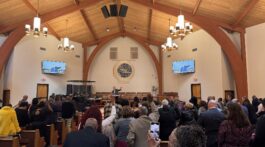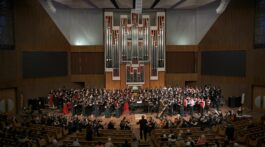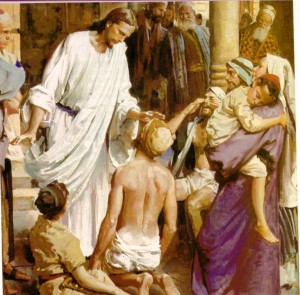Sabbath School Lesson for October 5-11, 2024
Overview and Introduction of Lesson 2, Signs of Divinity
Memory Text: “Jesus said to her, ‘I am the resurrection and the life. He who believes in Me, though he may die, he shall live. And whoever lives and believes in Me shall never die. Do you believe this?’ ” John 11:25, 26 NKJV
Jesus not only spoke words that told of His divinity, His actions verified His claims. When Jesus claimed to be the resurrection and the life, He backed it up by raising His friend, Lazarus, after he’d been dead four days!
That miracle, and several, unprecedented others, reveal that Jesus truly was the divine Son of God, not a created being. He has always existed, is in heaven now with His Father, and He will always be with us in the future. The great “I AM” is a title He and God share.
He has always been intimately connected with the human family. He spoke our world into existence and continues to speak to us through the Bible, the written word of God. Finally, He died to save fallen humanity. We can safely say, He was the Son of God and the Son of Man–fully human and fully divine. No one else can make that claim.
There are seven “I AM’ declarations that came from the lips of Jesus. This week, the miracles that proclaim the truth about His divinity are the ones that tell us He is the bread of life (John 6), the Light of the World (John 9), and the life and the resurrection (John 11). He truly is everything to His beloved followers.
This week we shall see…
- Sunday: The Feeding of the Five Thousand–John 6, the bread of life
- Monday: “Surely, He Is the Prophet”–the seven “I am” statements of Jesus
- Tuesday: The Healing of the Blind Man, Part 1–John 9, the light of the world
- Wednesday: The Healing of the Blind Man, Part 2″–how we are spiritually blind
- Thursday: The Resurrection of Lazarus–John 11, the resurrection and the life
Sunday: The Feeding of the Five Thousand
Many today are thrilled by Jesus’ miraculous feeding of the multitude with just a few loaves and fishes. The healing miracles He had already performed meant that crowds were soon following Him everywhere, especially since this particular miracle occurred near the time of the Passover (John 6:4). The feeding of five thousand people captivated the disciples’ hearts in a way that hadn’t been experienced since the time of Moses, when manna, called bread from heaven, fed the Israelites in the wilderness.
There are some interesting parallels in John’s Gospel story and the one in Exodus about Moses. First of all, John 6:3 mentions that Jesus had gone up on a mountain (as Moses often did). Then, John 6:5-6 says that Jesus “tested” Phillip by asking him where they might buy bread for everyone (just as the Israelites had been tested during their wilderness experience). And finally, after they were all fed that day, there were twelve baskets remaining. This must have been reminiscent of the twelve tribes of Israel.
The disciples couldn’t help but wonder if this Master they were following might actually be the long-awaited Messiah, the Prophet and Deliverer of Israel. They didn’t know it fully yet, but they were indeed getting glimpses of Christ’s divinity.
Bible Verses:
John 6:1-14
- What similarities do you see in Jesus’ feeding such a large crowd and the miracle of manna during the time of Moses?
Monday: “Surely, He Is the Prophet”
Most of the people in Judea, including the disciples, were looking for an earthly messiah, someone who would save them from the oppressive Roman Empire. Two things have always been needed for an army to achieve victory over its enemies: the troops have to be fed, and the wounded and dying must be cared for.
With the many healings Jesus had already done, and then blessing the food that miraculously fed so many, Jesus had proven dramatically that He could lead His people to victory against the hated Romans. But there was much more that Jesus had to show them. He would ultimately save them from eternal death by saving them from their sins. The full impact of a spiritual, heavenly kingdom was yet to be understood.
John, in wanting us to recognize Christ’s divinity, was purposeful in choosing the events he would record in his Gospel story. He scattered “I AM” statements from Jesus whenever they would get the most attention–such as after the miracles we see in John 6, 9, and 11.
Here are seven “I AM” proclamations found in John: I am “the bread of life” (John 6:35), “the light of the world” (John 8:12), “the door” (John 10:7, 9, “the Good Shepherd” (John 10:11, 14), “the resurrection and the life” (John 11:25), “the way, the truth, and the life” (John 14:6), and “the true vine” (John 15:1, 5).
Bible Verses:
John 6:14-15, 26-36
- What was wrong with the way the people responded to this miracle of feeding the multitude? Why were they thinking this way?
- How did Jesus try to explain the true purpose for His miracles? And what was that purpose?
Tuesday: The Healing of the Blind Man (Part 1)
There are a few instances in the Old Testament that convey the idea that sin is somehow connected with sickness–that the reason for sickness is because either that person or some member of his family had sinned. Examples of this might be the command about worshipping idols. Exodus 20:5 suggests that the children of the third and fourth generations would suffer for their parents’ idolatry. Then again, we recall the story in 2 Kings 5 of the greedy servant Gehazi, who acquired Naaman’s leprosy, and passed it on to his descendants.
Although many children often repeat the mistakes of their parents, and our own sinful lifestyles may contribute to our diseases, the story of Job should also inform us that sometimes God has a higher purpose in allowing us to suffer.
This was the case for a blind beggar Jesus encountered as they were leaving the temple one Sabbath. The disciples asked Jesus who had sinned, causing this unfortunate man’s blindness. Jesus replied that no one had sinned, but he would, through his blindness, reveal the works of God.
Jesus then declared Himself to be the light of the world, the One capable of curing our spiritual blindness (John 9:4-5).
Bible Verses:
John 9:1-16
- Why were the religious leaders divided about this event? What arguments caused the division?
- Why is light a symbol of God’s goodness, and darkness a symbol of our sinful state under Satan?
Wednesday: The Healing of the Blind Man (Part 2)
The hard-hearted Pharisees were so troubled by this healing that they even questioned the blind man’s parents to find some discrepancy in the testimonies they were hearing. Little did they realize their own spiritual blindness in not recognizing the Messiah, when He was right in front of their eyes.
The unique method Jesus used to heal the blind man in John, chapter 9, (anointing his eyes with clay, mixed with saliva) was designed to remind them of their Creator, who fashioned us out of dirt, or the dust of the ground (Genesis 2:7). Just as the feeding of the five thousand reminded them of manna during the exodus, this healing experience was also intentional in pointing out the divinity of Christ as our Creator.
When Jesus proclaimed Himself to be the light of the world (John 9:5), He was telling us that He wants to bring spiritual understanding to His people, just as He created light on the first day of creation (Genesis 1:2-3). Our dark, sin-hardened world needs His light again now, more than ever!
Bible Verses:
John 9:17-34 and 1 Corinthians 1:26-29
- Who were the wise and foolish ones in John’s Gospel?
- Why are the foolish and weak often the ones who recognize God? What prevents smart, powerful, rich people from doing so?
Thursday: The Resurrection of Lazarus
The one outstanding miracle of Jesus that proved He is our Life-Giver, the Creator of life from the beginning of time, was the raising of Lazarus after he’d been dead several days. Jesus was close to the family of three siblings, Martha, Mary, and Lazarus. Grief would be painful for the sisters, but He knew they had the faith to weather any storm. He also loved them so much that He couldn’t resist the opportunity to use their tragedy to glorify God.
Therefore, when told of Lazarus’ sickness, He stayed where He was two more days before going to their assistance (John 11:6). When told of His friend’s death, He wept (John 11:35). When He made the unusual request for them to take the stone away from the tomb, they reluctantly obeyed, reminding Jesus that there would be the smell of a rotting corpse in the tomb after four days.
After the stone was gone, Jesus spoke the words, “Lazarus, come forth!”, and immediately he came out of the tomb, bound from head to foot in graveclothes, from which Jesus said to unwrap and free him (John 11:43, 44).
Jesus miraculously demonstrated that He is the resurrection and the life, as He claimed. But the proud, religious council continued their accusations, thinking they could stop His ministry by killing the Giver of Life.
Bible Verses:
John 11:1-46
- Why did Jesus weep with His friends, when He knew what He was about to do for them?
- How did Jesus support His claim of divinity and show that He is the resurrection and the life?
- What kind of life does Jesus provide all His followers? How have you felt more alive by knowing Him?
Friday: Final Thoughts
It must have been wonderful to be a disciple and live so close to Jesus that signs of His divinity were noted and later remembered. After Jesus went back to heaven, the Holy Spirit has provided us with comfort and peace. In addition, we have comfort in reading God’s holy word, the Bible.
One Christian author beautifully expressed the comfort and support of the Scriptures this way:
“When His visible presence should be withdrawn, the word must be their source of power. Like their Master, they were to live ‘by every word that proceeds out of the mouth of God.’ Matthew 4:4 As our physical life is sustained by food, so our spiritual life is sustained by the word of God….We should carefully study the Bible, asking God for the aid of the Holy Spirit, that we may understand His word.” ~Ellen G. White, The Desire of Ages, p. 390.
Next Week: The Backstory–The Prologue
To read the Sabbath School Lesson Quarterly and see more resources for its study, go to










